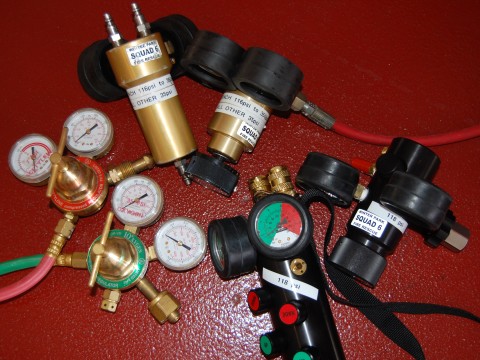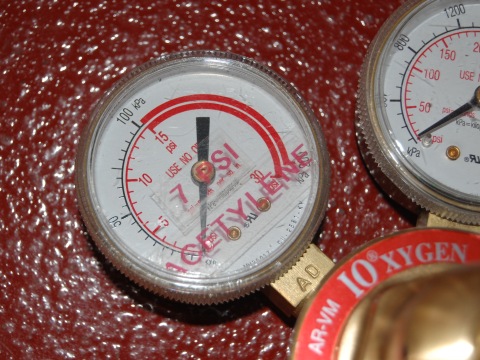
With all of the different settings we have to remember for different types of equipment, here is a simple way to ensure that they are never forgotten. Make up a label for each setting and place on gauges and controllers. This allow for the setting to be remembered in a pinch. Obviously we would rather be able to say that the settings are never forgotten, but we want to guarantee that they are always correct. These labels have been placed on the lift-bag controllers, pneumatic shores, air tools, and cutting torches. This tip works very well on equipment that has different setting for different uses like the pneumatic shores. It’s a simple idea to ensure that the equipment is always being used in a safe and efficient manner.


Very handy for us forgetful types.
Sadly the next step (for me) is to attach a magnifying glass to each gauge.
🙁
We just use a sharpie and put a notch at where the psi should be at.
We do this as well, P-Touch labels are great for all types of markings. We also use the Sharpie paint markers on alot of our tools. We have many of our lifting tools (bottle jacks, porta powers, hydraulic tools, etc) marked with their closed and open sizes along with their rated lifting/spreading capacities.
Of course it is not possible to accurately determine the sizes or weights of every object when on the scene but it gives the members a starting point, or if nothing else, starts them thinking about what tool should be used from the start instead of figuring it out half way through an operation when a tool stops working
As an additional tip, after you put the P-touch label on, put a coat of Clear 5 minute epoxy over it. I will keep it from peeling off or getting torn. We do this on all of our tools and tool boxes that get labeled. It keeps you from having to re-label every few weeks.
This may work for systems such as compressed air or the like but is VERY dangerous and unsafe for OA torches. My father is a high school tech ed teacher, with a masters degree in industrial safety, he DRILLED it in to our heads that setting and forgetting gauges for oxyacetylene (OA) torches is not good. if you “preset them” the needle valves will be suddenly pressurized when the system recieves pressure, thereby reducing the accuracy of the readout. this may seem trivial, but acetylene starts to become unstable as it gets pressurized beyond 15psi. thats not a whole heck of a lot. my father always said to back the valves out till they are spinning freely, as per mfg’ers instructions. also, there is no way to preset OA torches if you have multiple tips. Each size tip requires a different setting. will it work on a different setting? maybe, sometimes, prob not as good as if it were the CORRECT one. i dont remember the formula for the settings off by heart, cause i dont use OA much, but ill do a repost in a day or so with that info. stay safe out there. but also be smart.
I put the sharpie to use for some of the guys with poor vision. 5-10 for Oxy 30-40 for o2, 135 for the air bags, and 90 for the whizzer. I also take my paint pen and mark everything they come in. Paint pen is much better than sharpie cause you can get it in colors to contrast.
Thanks, great tip.
119… I agree 100% we don’t leave anything preset, everything gets backed off. That why we have the labels. The title of the post may have been a little misleading. As I was writing it all I could think of was that commercial for some kitchen appliance a few years back when he kept saying “set it and forget it.” -Jimm-
Glad to see I’m not the only Ron Popeil fan out there. 🙂
While we label our gauges, we also mark the plywood ground pads for our air bags. Each pad is cut to the size of the bag and the capacities/pressures are written with the trusty ol’ sharpie in large print. Keep up the good tips.
I am glad to see my department is not the only one that has to “DUH PROOF†our equipment, I swear at one point I was going to put arrows on the flathead one side for cutting one for striking!!! Lots of good tips and tricks thank you..:-)
paint pens and sharpies are great for so many things. we mark our hydrant assist valves and inline “z” valves for those 3 AM reminders on which gate goes to which discharge, etc. we too have marked our airbags with their lifting capacity and height to which they can lift. label makers never really stand up to our work environment too well. the epoxy idea is a good one… i’ll have to give that a try.
stay safe.
We have to draw pictures on our Paratech stuff for the guys like Mongo.
I failed to mention it and 119 did about backing off the knob on the diaphram for the regulator. It is also important to do this cause of the spring inside, if it is held down constantly it will create a ‘memory’ in the regulator and will not allow it to operate properly.
Another reason to back all those T handles off.
We use a pressure guage which gets connected to the riser of a standpiped building. We were considering, just the other day, to p-touch the guage with a ‘cheat sheet.’ Not that its hard math but it’s just one less thing to think about. The only thing that would have to be taken into account is how many floors above or below the connection and weather or not we’re using one or two of our high-rise bags. Other than that the beginning psi number would be written right there for you.
good post!
HAHAHA HOHOHO HEHEHE you are sooooooooooooooooo funny DMAN lol
The epoxy works well unless the surface is smooth or exposed to UV light for extended pd’s of time. my college shop put paper barcodes on all the power tools in the shop that way, most of them fell off after a few uses. I might consider something a little more potent, such as the epoxy they use to coat bar tops. plus you get more than in a tube.
OK ya got to know I love ya all like a brother but there are wayyyyy to many engine guys in here!!! May I suggest http://www.chargetheline.blogspot.com/ or http://www.firefighterhourly.com/ for you hose draggers!!! JEEZZZZ I am sorry Jimm,, I hope I did not break any rules I am just saying!!!!
119, Thanks for the idea about the bar top epoxy, I will look into it and pass the idea along to the LT who feels the need to label everything.
Jon is 100% right about leaving the pressure gauges preset on the Oxy-acetylene. Part of your morning check should be to see which tip is on the torch. You never know when the other shifts has changed the tip (or god forbid, burned it up) when they were drilling. This will get you in the habit of figuring out the different pressures for the different tips.
I suppose it might be a necessary evil to mark everything with is operating pressure as a reminder at 3 in the morning. I hope the P-touch and paint haven’t worn off by the time you need to use something. There is no better memory tool (in my opinion), than putting your hands on something and actually drilling with it. A paint pen or P-touch labeler may tell you what pressure to operate something at, but it sure as hell isn’t going to tell you if you didn’t set it up right or why it isn’t working when you need it. Only hands on time with the tool (and the owner’s manual) can give you that knowledge.
One of the post suggested using clear coat to protect labels, SO for the smaller labels, just use clear finger nail polish, easy to apply because of the brush in the bottle cap, AND we use it to mark tools that match, Sparkle red, yellow, green whatever.
Problem with clear coat is that it sprays all over, or if you use the brush on from the can, once opened it tends to harden.
Being somewhat of a problem solver, I have found the when using the Paratech or other brand of regulator, you can maintain a better presure if you put an inline chamber, about 1/4 cub.ft. which tends to supply a constant air pressure to the tool, with out the fluxuation that will occur when going straigth to the tool from the point of conection. (of curse make sure it is rated) for the max. out air pressure of the regulator. Of course the larger the chamber the better, as it provides a constant flow, not what you get with the output from the regulator, as it is supply only what volume is in the length of air line, this also softens the impact of airflow to the tool.